September is National Service Dog Month, a time dedicated to celebrating and appreciating the tireless work of service dogs. These highly trained animals provide an invaluable service to people in need, from those with physical disabilities to those suffering from mental health conditions.
During this month, we honor these furry heroes and recognize the important role they play in society and the impact they can make to a disabled person.
Service dogs are trained to perform specific tasks to assist their human companions, such as alerting them to sounds, guiding them through crowds, or providing emotional support. They are carefully selected and trained for their specific roles, and their work can make a huge difference in the lives of those they assist.
National Service Dog Month is an opportunity to highlight the incredible work that these animals do and to raise awareness of the importance of their role in society.
Whether you have a service dog yourself or simply appreciate the work that they do, National Service Dog Month is a time to show your support and gratitude.
Join us in celebrating the hardworking service dogs who dedicate their lives to helping others, and help raise awareness of the vital role they play in our communities during National Service Dog Month.
History of National Service Dog Month
As mentioned, National Service Dog Month is a time devoted to raising awareness and showing appreciation for the extraordinary work service dogs do every day for the people in their care. It is celebrated every September in the United States.
The idea of National Service Dog Month was first proposed by actor and founder of Natural Balance Pet Food, actor Dick Van Patten, in 2008.
Van Patten was so impressed with the work done after he visited the of Guide Dogs of the Desert program in Palm Springs California that he wanted to raise money on a larger scale for programs all around the country and would later serve as an honorary board member.
The following year, the Petco Foundation helped to establish National Guide Dog Month, which was celebrated during the month of May. In 2011, the month was renamed to National Service Dog Month to include all types of service dogs, not just guide dogs.
National Service Dog Month is an opportunity to recognize the important role that service dogs play in the lives of people with disabilities.
Service dogs are trained to perform specific tasks to assist their owners, such as guiding the blind, alerting the deaf, detecting seizures, and providing emotional support.
This month is also dedicated to the large-scale fundraising effort in place to help non-profit service dog training programs running.
Over the years, National Service Dog Month has grown in popularity and has become an important event in the service dog community. It is an opportunity to educate the public about the benefits of service dogs and the important work they do.
Many organizations and businesses hold events and fundraisers to raise awareness and support for service dogs and their owners.
In conclusion, National Service Dog Month is a time to celebrate and honor the special heroes who dedicate their lives to help their human companions. It is an opportunity to raise awareness about the important work that service dogs do and to show appreciation for their service.
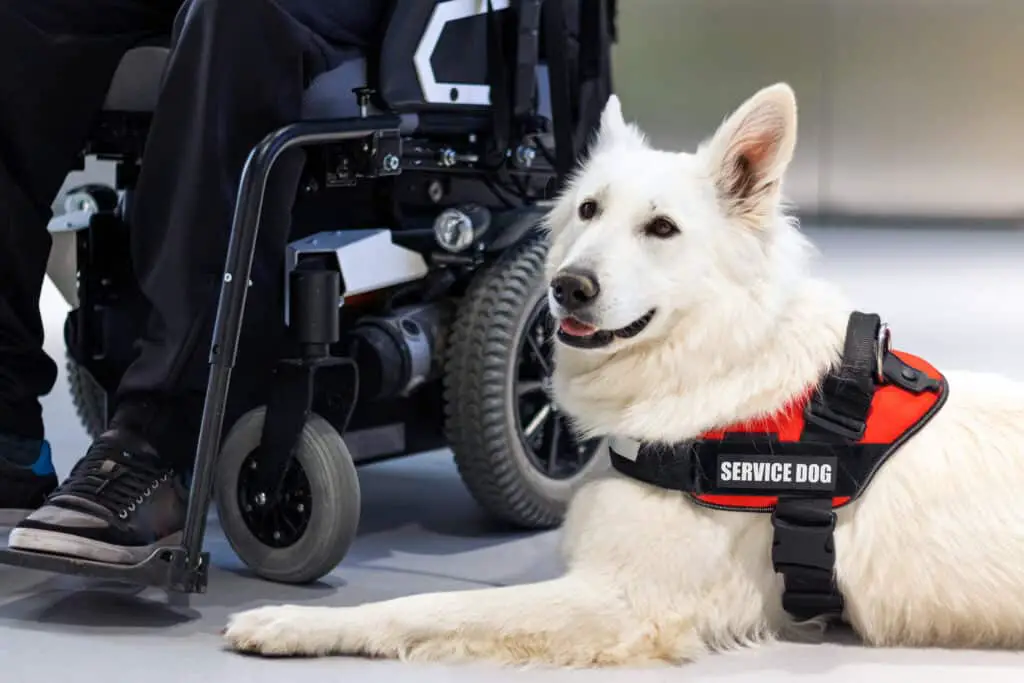
Importance of Service Dogs
Unlike a pet dog, service dogs are highly trained animals that provide assistance to people with disabilities. These dogs undergo formal training to perform a variety of tasks and can help people with physical disabilities, hearing impairments, and mental health conditions.
They can provide a sense of independence and freedom to their handlers, allowing them to live more fulfilling lives.
Service dogs are not just pets; they are working dogs that have been trained to perform specific tasks. These tasks can include guiding their handlers through busy streets, alerting them to sounds they cannot hear, and providing emotional support during times of stress or anxiety.
Service dogs can also help their handlers with day-to-day tasks, such as opening doors or retrieving dropped items. We’ve seen service dogs that will get pills and water for their handler when they are in the middle of a health event.
One of the most important aspects of a trained service dog is their ability to improve the quality of life for their handlers.
These dogs can provide a sense of security and companionship that can be difficult to find elsewhere. They can also help their handlers to feel more confident and independent, which can lead to a greater sense of self-worth and happiness.
In addition to the emotional benefits, service dogs can also provide practical benefits to their handlers. For example, they can help people with disabilities to live more independently by performing tasks that would otherwise be difficult or impossible. This can include tasks such as turning on lights, opening doors, and retrieving items.
Overall, service dogs play an important role in the lives of many people with disabilities. They provide a sense of independence, companionship, and practical assistance that can be difficult to find elsewhere.
National Service Dog Month is an important opportunity to recognize the hard work and dedication of these amazing animals and the vital role they play in our society.
Types of Service Dogs
Service dogs are trained to assist individuals with disabilities and medical issues in a variety of ways. Here are some of the most common types of service dogs:
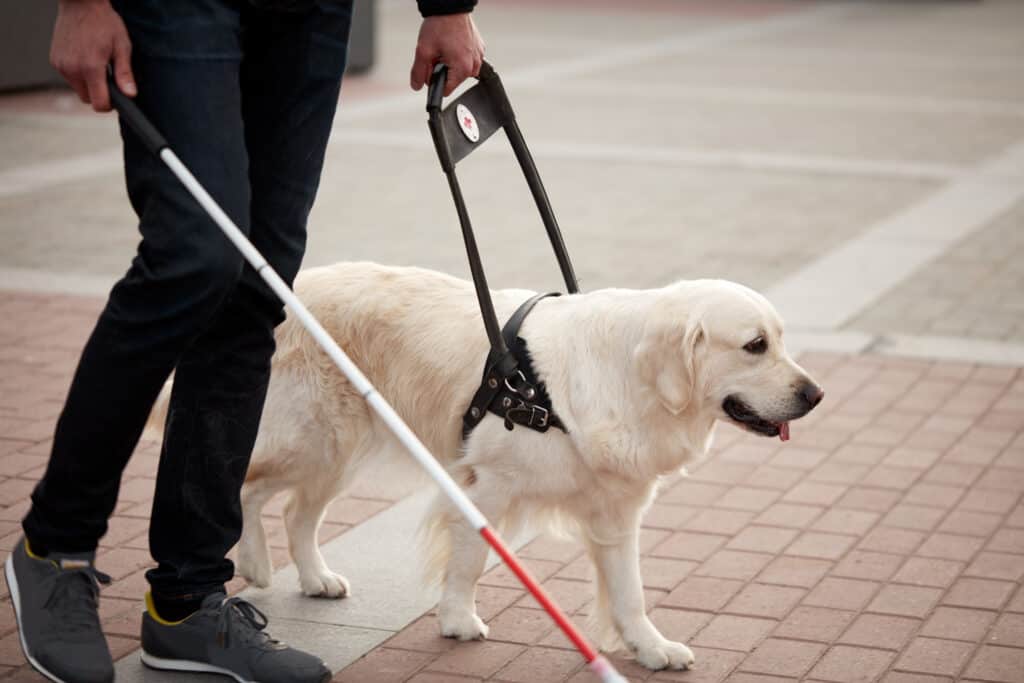
Guide Dogs – Leader Dogs for the Blind
Guide dogs trained in a Leader Dog Guide Dog Training program, also known as leader dogs or seeing eye dogs, receive special training to help individuals who are blind or visually impaired navigate their surroundings.
These dogs are trained to avoid obstacles, navigate street crossings, and follow directional commands. Guide dogs are typically medium to large in size and have a calm, confident temperament.
Leader Dogs for the Blind in Rochester Hills, MI is one such training program. When you visit the city, you will often see trainers training dogs and/or teaching blind people how to work with the trained dogs. The entire downtown is set up with crosswalks that tell walkers how much time they have left in the crosswalk before the light turns green.
They even have a Rochester Hills Leader Dogs Spring Carnival in May.
Hearing Dogs
Hearing dogs are trained to assist individuals who are deaf or hard of hearing. These dogs are trained to alert their handlers to important sounds, such as doorbells, smoke alarms, and approaching vehicles. Hearing dogs are typically small to medium in size and have a keen sense of hearing.
One training program is Paws With A Cause. Along with doorbells and smoke alarms, these dogs are trained to hear a telephone ringing, a baby or child’s cry. They can even be taught to understand American Sign Language.

Psychiatric Disabilities Service Dogs
Psychiatric service dogs are trained to assist individuals with mental health conditions, such as anxiety, depression, and post-traumatic stress disorder (PTSD) and other mental disorders. These therapy animals are trained to perform a variety of tasks, such as providing comfort, interrupting harmful behaviors, and alerting their handlers to signs of an oncoming panic attack.
Psychiatric service dogs can vary in size and breed. These dogs receive a wide array of training for helping military veterans to cope with PTSD to Traumatic Brain Injury (TBI).
Autism Support Dogs
An autism support dog is trained to assist individuals with autism spectrum disorder (ASD). These dogs are trained to provide comfort, promote social interaction, and prevent wandering. Autism support dogs are typically medium to large in size and have a calm, patient temperament.
Seizure Alert Dogs
A seizure alert dog is trained to assist individuals with seizure disorders. These dogs are trained to detect oncoming seizures and alert their handlers or others nearby. Seizure alert dogs can vary in size and breed.
Paws with a Cause, along with hearing dogs, train dogs to help people with seizure disorders.
Diabetic Alert Dogs
Diabetic alert dogs are trained to assist individuals with diabetes. These dogs are trained to detect changes in their handler’s blood sugar levels and alert them to take action. These lifesaving service dogs can vary in size and breed.
Cardiac Service Dogs
Cardiac service dogs are trained to assist individuals with heart conditions. These dogs are trained to detect changes in their handler’s heart rate or blood pressure and alert them to take action. Cardiac service dogs can vary in size and breed.
Overall, service dogs play an important role in assisting individuals with disabilities. The type of service dog needed depends on the individual’s specific needs and disabilities.
Mobility Assistance Dogs
Mobility dogs have the potential to help you with every aspect of traveling via public transportation, including buses and airlines.
People who have impairments can benefit greatly from having a companion animal in the form of an assistance dog because these companion animals provide more than just company for their human partner and are relied on for a variety of day-to-day activities.
Mobility assistance dogs are a specialized breed of service dog that are trained to aid their handlers with movement of any kind, including walking, using a wheelchair, or moving around in other ways. They offer support to their handlers when moving from one location to another.
They are of tremendous assistance, not only in public settings but also in your own house as well. Your dog will be able to open and close doors, turn lights on and off, and locate other people in the house when assistance is required if you design your home so that it can handle a variety of duties.
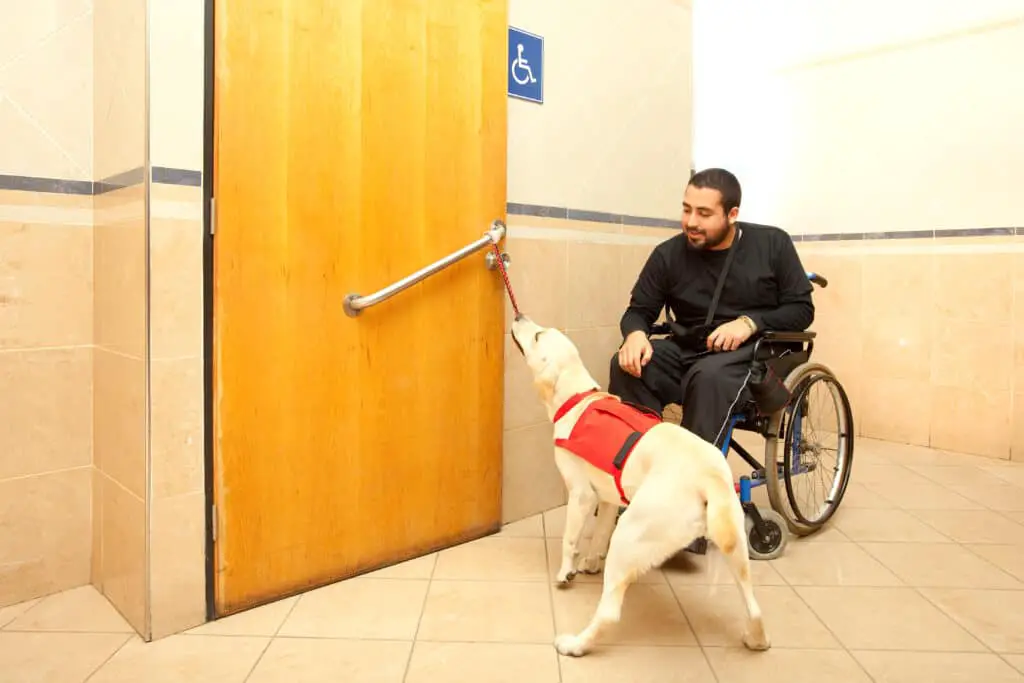
Wheelchair Assistance Dogs
Wheelchair Assistance Dogs are specially trained canines that provide invaluable aid to individuals with mobility challenges. These remarkable dogs are skilled at tasks such as retrieving dropped items, open and close doors, and assisting their handlers with everyday activities.
By offering both practical support and unwavering companionship, Wheelchair Assistance Dogs empower their handlers to navigate the world with greater independence and confidence.
Again, Paws with a Cause trains dogs to help people with disabilities.
Training and Certification Process
If you’re interested in getting a service dog, it’s important to understand the training and certification process that these dogs go through. Here are the three main stages of training and certification:
Puppy Training
Service dogs start their training as puppies. They are usually bred for specific tasks, such as guiding the visually impaired or alerting their handler to sounds.
During puppy training, the dogs learn basic obedience skills, such as sitting, staying, and coming when called. They also learn how to socialize with people and other animals.
The dogs that have had the most success as service dogs are Golden Retrievers, Labrador Retrievers, German Shepherds, Poodles, Border Collies, Bernese Mountain Dogs and Boxers.
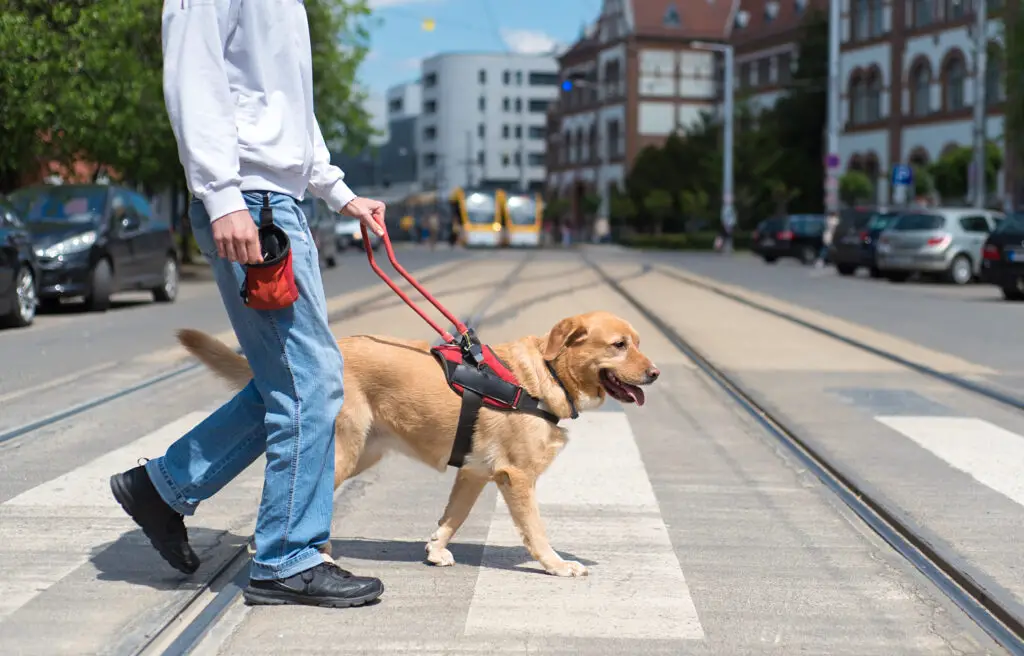
Public Access Test
Once the puppy training is complete, the dog must pass a public access test. This test ensures that the dog is well-behaved in public and won’t cause a disturbance like an untrained dog. During the test, the dog must demonstrate that it can perform tasks, such as retrieving objects and opening doors, in a controlled environment with distractions.
Task Training
The final stage of training involves task training. This is where the dog learns specific tasks that will assist its handler. For example, a dog trained to assist someone with mobility issues might learn how to retrieve dropped items, open doors, and help with balance.
A dog trained to assist someone with a hearing impairment might learn how to alert its handler to sounds, such as a doorbell or smoke alarm.
It’s important to note that there is no official certification process for service dogs in the United States. However, many organizations offer certification programs that can provide additional training and help ensure that your dog is well-behaved in public.
It’s also important to remember that training is an ongoing process, and you will need to continue working with your dog to maintain its skills and behavior.
Benefits of Service Dogs to Individuals
Service dogs provide a range of benefits to individuals with disabilities, including physical, emotional, and psychological support. Here are some of the benefits of service dogs to individuals:
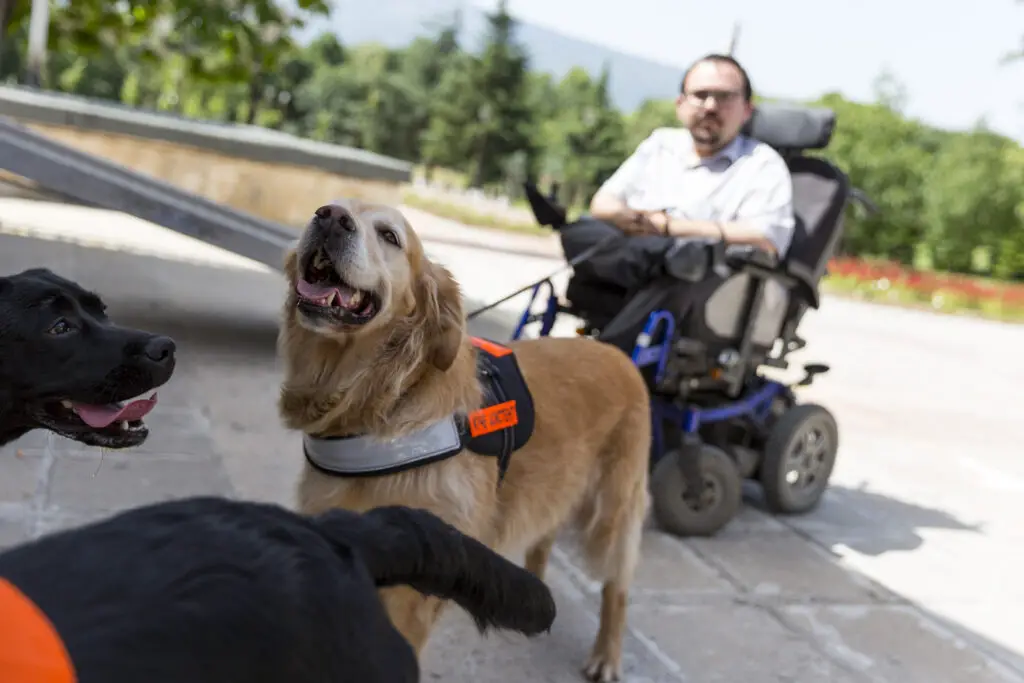
Physical Benefits
Service dogs can provide physical assistance to individuals with mobility issues, such as those who use wheelchairs or have difficulty walking. They can help with tasks such as opening doors, retrieving objects, and turning lights on and off.
Service dogs can also assist individuals with hearing or vision impairments by alerting them to sounds or guiding them through crowds.
Emotional and Psychological Benefits
Service dogs can provide emotional and psychological support to individuals with mental health conditions such as anxiety, depression, and post-traumatic stress disorder (PTSD). They can help reduce stress and anxiety levels, provide a sense of security, and increase feelings of happiness and well-being.
Service dogs can also help individuals with autism by providing sensory support and reducing anxiety in social situations. Nothing beats the healing powers of the human-animal bond.
Increased Independence
Service dogs can help individuals with disabilities increase their independence and improve their quality of life. They can assist with daily tasks such as getting dressed, preparing meals, and taking medication.
Service dogs can also help individuals with disabilities feel more confident and self-sufficient in their daily lives.
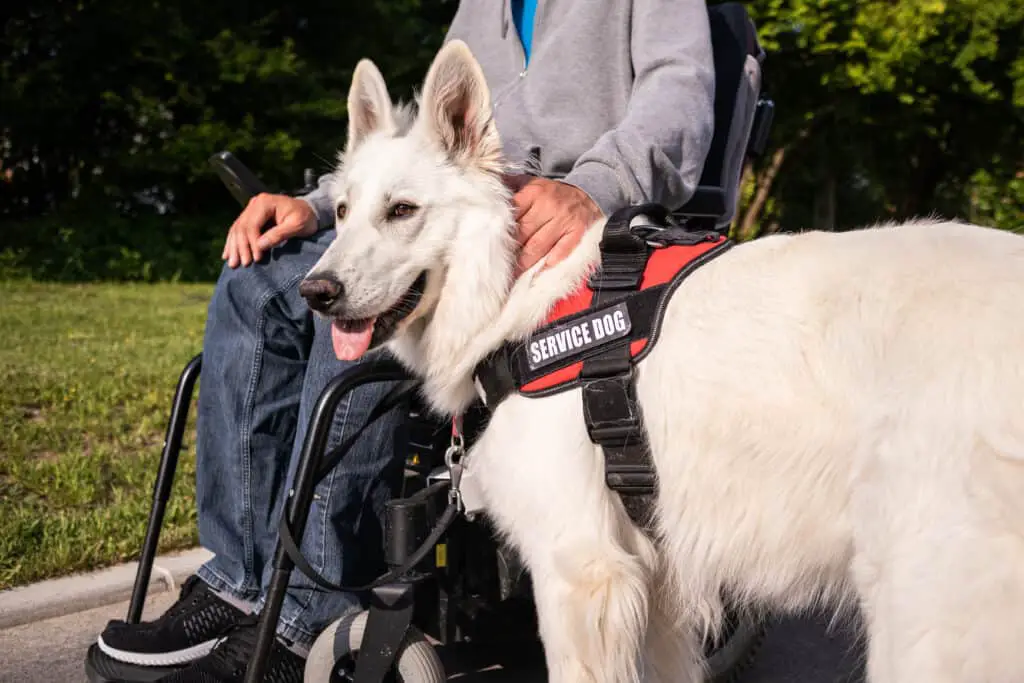
Companionship
Service dogs can provide individuals with disabilities with a constant companion and source of emotional support. They can help reduce feelings of loneliness and isolation, and provide a sense of purpose and meaning in life.
Overall, service dogs can provide a range of physical, emotional, and psychological benefits to individuals with disabilities. They can help increase independence, improve quality of life, and provide a constant companion and source of support.
Challenges and Controversies of National Service Dog Month
National Service Dog Month is a time to celebrate and honor the amazing work that service dogs do for their human companions. However, there are also challenges and controversies surrounding service dogs that need to be addressed.
One of the biggest challenges is the issue of service dog fraud. Unfortunately, some people try to pass off their pets as service dogs or therapy dogs in order to gain access to public places or transportation. This not only puts the safety of others at risk but also undermines the legitimacy of service dogs and the important work they do.
Another challenge is the lack of standardization when it comes to service dog training and certification. While the Americans with Disabilities Act (ADA) provides some guidelines, there is no national standard for training or certification. This can lead to confusion and inconsistency, making it harder for businesses and individuals to know how to properly accommodate service dogs.

There are also controversies surrounding certain breeds of dogs being used as service dogs. Some people believe that certain breeds, such as pit bulls or Rottweilers, are inherently dangerous and should not be used as service dogs. However, the ADA does not discriminate based on breed and instead focuses on the individual dog’s behavior and training.
Another controversy is the use of emotional support animals (ESAs) as service animals. While ESAs can provide comfort and support to their owners, they do not have the same level of training and public access rights as service dogs. This has led to confusion and abuse of the ESA designation.
Overall, while there are challenges and controversies surrounding service dogs, it is important to recognize the vital role they play in the lives of their human companions. It is up to all of us to work together to ensure that service dogs are properly trained, certified, and respected.
How to Support National Service Dog Month
If you want to show your appreciation for the extraordinary work service dogs do every day, here are some ways you can support National Service Dog Month:
- Attend a Dog event: Check your local area for events that celebrate the bond between dogs and people even if it’s not during National Service Dog Month. Leader Dogs for the Blind in Rochester Hills has the Bark & Brew festival every June. It’s a wonderful fundraising event for the Leader Dog program.
- Create a personal fundraising drive in honor of service dogs: You can create a personal fundraiser to raise money for a service dog organization in honor of National Service Dog Month. You can set up a fundraising page on a platform like GoFundMe or Facebook and share it with your friends and family.
- Become an Advocate: Share information about National Service Dog Month on social media or with your local community. You can also contact your local representatives to advocate for service dogs and their handlers.
- Sponsor a puppy: Many service dog organizations offer puppy sponsorship programs. You can sponsor a puppy and help cover the costs of their training and care.
- Volunteer for a training program you can go further and raise a puppy yourself or host a breeding dog. If you do this, please ask the organization you would like to raise a puppy for how to do this. There are guidelines to follow. Be sure that you are ready for a 12-15 month commitment.
- A social media campaign showing the development and training of the puppy would be a great way to raise awareness for service dogs and National Service Dog Month.
Remember, service dogs play a vitial role in the lives of their handlers. By supporting National Service Dog Month, you can help raise awareness and show your appreciation for these special heroes.
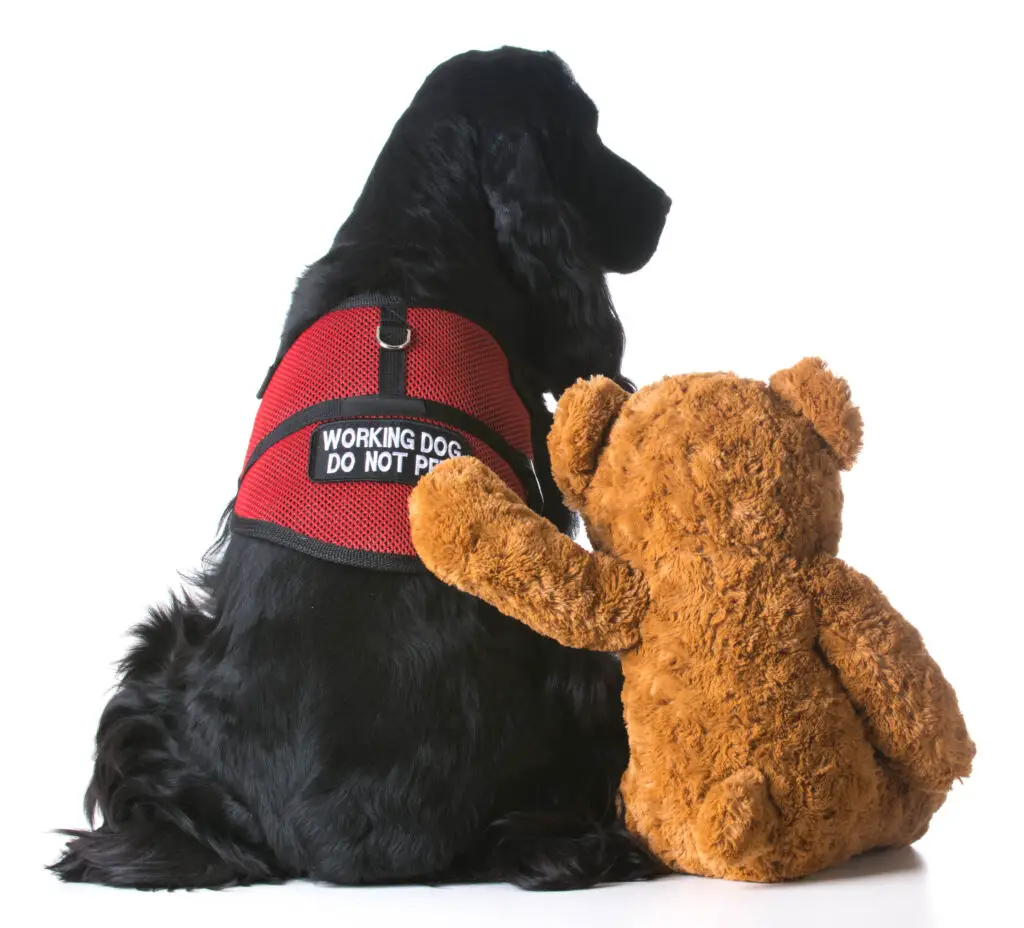
Frequently Asked Questions
What is the purpose of National Service Dog Month?
National Service Dog Month is celebrated every September to raise awareness and appreciation for the extraordinary work that service dogs do every day.
The main purpose of this month is to recognize the important role that service dogs play in the lives of people with disabilities, and to honor the hard work and dedication of the organizations that train and provide these dogs.
How can I support organizations that train service dogs during National Service Dog Month?
There are many ways to support organizations that train service dogs during National Service Dog Month. You can donate money, volunteer your time, attend fundraising events, or even sponsor a puppy. You can also become an advocate for service dogs by spreading awareness and educating others about their importance.
What is the difference between a service dog and emotional support dogs?
A service dog is trained to perform specific tasks to assist a person with a disability, while an emotional support animal provides comfort and emotional support to their owner.
Service dogs are allowed to accompany their owners in public places, while emotional support animals are not always granted the same rights under the law.
What are the benefits of having a service dog?
Service dogs can provide many benefits to their owners, including increased independence, improved mobility, and enhanced emotional well-being.
They can also help with tasks such as opening doors, retrieving dropped items, and alerting their owner to potential dangers.
How are service dogs matched with their owners?
Service dogs are carefully matched with their owners based on the specific needs and abilities of the individual. The training process is tailored to the individual’s needs, and the dog is trained to perform tasks that will assist their owner in their daily life.
One YouTuber with Cystic Fibrosis has a service dog that can even pull a full basket of laundry up the stairs.
What is the history behind National Service Dog Month?
Since then, this National Service Dog Month has been celebrated every September to raise awareness and appreciation for the hard work and dedication of service dogs and their trainers.
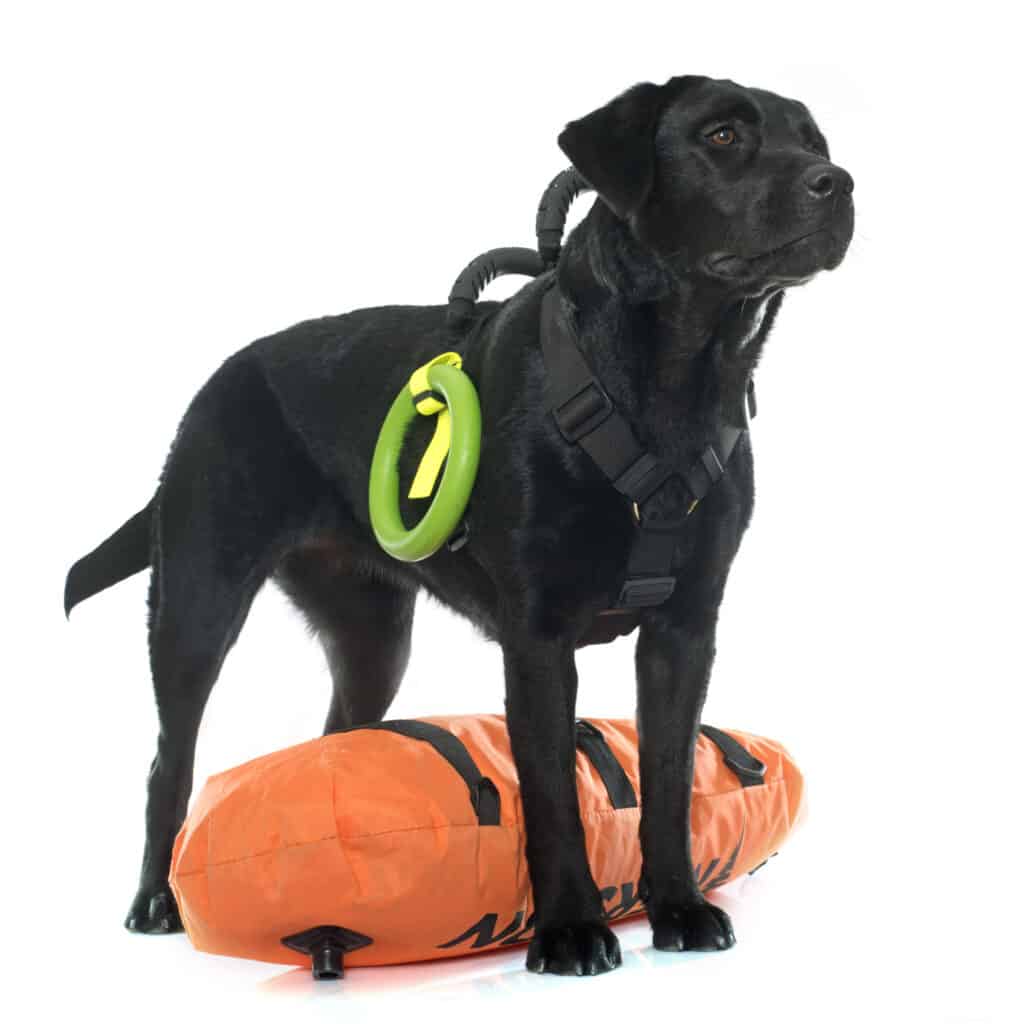
The Bottom Line on National Service Dog Month
National Service Dog Month is celebrated every September to raise awareness and show appreciation for the work of service dogs. These amazing animals are more than just pets, as they have been trained to take care of humans suffering from certain ailments, disabilities, or mental health issues.
During National Service Dog Month, it is important to recognize the hard work and dedication of service dogs and their handlers. Service dogs undergo rigorous training to learn how to assist their owners with various tasks, such as guiding the blind, alerting the deaf, and detecting seizures.
They also provide emotional support and companionship to those struggling with mental health issues.
National Service Dog Month is a great opportunity to learn more about service dogs and the important role they play in our society. It is also a chance to support organizations that train and provide service dogs to those in need.
If you are interested in getting involved, there are many ways to show your support. You can donate to a service dog organization, volunteer your time to help train service dogs, or simply spread awareness about the importance of these amazing animals.
Remember, service dogs are not just pets, they are highly trained professionals who provide essential support to those in need. So, take some time during the National Service Dog Month to show your appreciation for the hard work and dedication of service dogs and their handlers.
Please read our Legal Disclaimer

